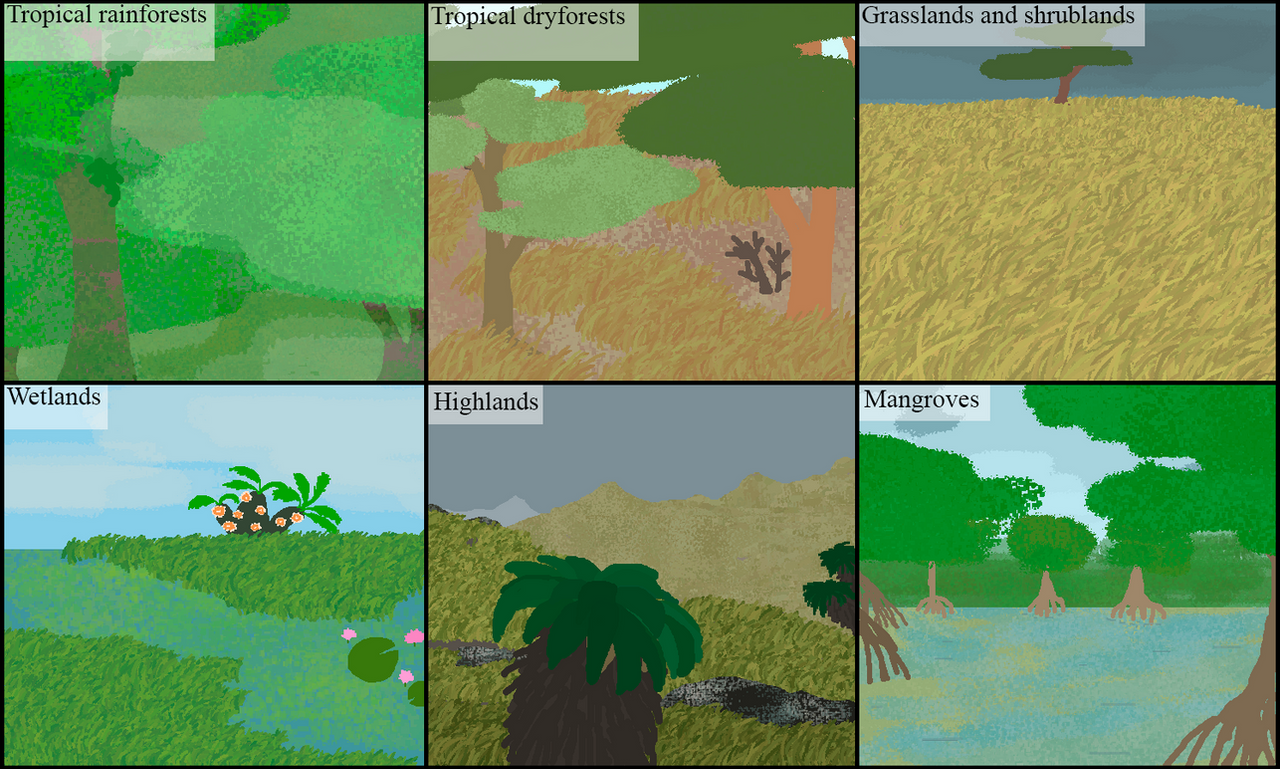HOME | DD
 AvaiSJ — Ecosystems of Paccai
AvaiSJ — Ecosystems of Paccai

Published: 2021-12-07 22:30:03 +0000 UTC; Views: 4870; Favourites: 15; Downloads: 0
Redirect to original
Description
Tropical rainforestsThe green, blooming dense rainforests cover much of Paccai's east, many parts ot them still barely touched by human activity. There, massive trees tower above the landscape, forming a dense canopy. Under them, smaller arboreals are located, and in the bottom there's the understory of various shrubs, herbs, ground-covering plants and fungi.
From the canopies to the ground, all levels of rainforest are full of life. The high trees, their branches covered in vines and epiphytes, are home to various birds, reptiles, amphibians, invertebrates and arboreal mammals, all of them flickering among the branches, often colourful.
The understory is home to various insects and other invertebrates, crawling among the litter. Small mammals, ground birds, amphibians and reptiles are there too, as are some of the larger animals. Rainforests are home to few megafaunals, but who are found there are the large, weird-looking browsing and foraging mammals, many of them belonging to ancient groups, as well as giant flightless herbivorous birds. Frugivores are very common, as fruits are very abundant there. Obviously, there are various large predators of various ancestry too, some of them pursuiting their prey among the branches and others hunting in the lower layers of forest.
Tropical dryforests
Dryforests' existance is dependant on monsoon, which brings abundant rainfall to the region in the summer. Summer rains often cause floods, but bring greenery and blossom, while dry winter cause the region to curdle until the next rains.
These places are nowhere as dense as rainforests are. Sparseness of large trees allows more sunlight to reach the bottom of the forest, which makes amounts of smaller trees, shrubs and herbs to be higher. In fact, understory here is extremely dense and often prickly, which makes it hard for humans, for example, to move through it.
The presence of abundant shrubs and occasional large trees makes these places hospitable for various browsing animals - large and small mammals mostly. Dryforests' megafauna is mostly composed of large browsers. Some grazing animals also exist, but their diversity is smaller than in savannas.
The dryforests are home to a variety of birds and other reptiles, as well as insects. Amphibian diversity is lower, most of them being ground-dwelling and hibernating in dry season. As for the mammals, various small swarm in the grass and shrubs, while their large relatives walk around. The predators of dryforests include both sauropsid and synapsid lineages, both of them being varied from tiny to enormous.
Savannas, grasslands, shrublands
Drier than the monsoonal forests, grasslands are also home to monsoonal rainforests - but wet season here is shorter and less intense, while dry season is long and, well, dry. This environment suits few trees, which mostly are very sparse, occasionally getting more dense in a parkland-like places. Most of ground is covered with grasses and shrubs.
These places are extremely hospitable for grazers and seed-eaters - from tiny invertebrates to giant mammals. Almost all of island's megafauna is found here, large mammal herds consuming grass and migrating across the savannas in search of fresher, greener plants. Browsers are rare, mostly occasionally walking there from the rainforests.
Most of birds here are groundbirds, foraging for seeds, insects or larger animals, and some even going after the giant megafaunal mammals. The mammal diversity is incredibly high in all sizes, while most non-avian reptiles are small, many burrowing. Amphibians are very rare, mostly found at river shores, lakes and wetlands, while invertebrates, as usual, are diverse, many hematophagous and following the large mammals.
The predators of megafauna include giant birds and mammals, their numbers almost as high as the numbers of African savanna carnivores.
Wetlands
From river floodplains and deltas to rainforest swamps and temperate highland marshes, wetlands are perhaps the most diverse biome of Paccai. They are found in all parts of island and are perhaps the most biodiverse part of it.
Some of these landscapes are covered in trees, many adapted to grow in water, others are grassy, herb- or bush-covered, and many, especially cold highland bogs, are mossy. From ancient, primitive horsetails, ferns and mosses to weird, colourful angiosperms and cycadeoids, the plants of wetlands are incredibly varied, but almost all of them are united by their adaptations to wet environment. Many grow in the water or by it's shores.
Wetlands are home to various herbivorous animals, many eating water plants, some grazing or browsing, eating fruits or seeds. The largest herbivorous mammal of Paccai is actually found in tropical wetlands and mostly eats water plants.
The predators are varied too - piscivores hunting fish, insectivores eating the various invertebrates and large predators attacking megafauna.
Birds and amphibians are two groups most diverse at wetlands, former including lots of waterbirds nesting, foraging or wintering in the swamps and marshes and latter including members of all four major amphibian groups occupying various niches from fully aquatic to arboreal.
Mammals, reptiles and invertebrates are diverse too, especially small mammals and aquatic reptiles of three largest groups.
Highlands
The high hills and mountains of Paccai have very different environments from the lowlands, mainly because of the colder, harsher climate and high elevation's effects on life. The peaks are almost lifeless, covered in glaciers and barren rocks. Below them begins the layer of sparse herbs, lichens and mosses, and below that there's the alpine tundra. Under tundra there are subalpine, temperate and subtropical montane forests.
The plantlife of highlands is weird - giant rosette asteraceans, krummholz forests, conifers, incredibly diverse small herbs and many relic, "living fossil" species. From alpine tundra bogs to hill subtropical rainforests, flora is very varied.
So is fauna - mountains of Paccai have few megafaunal species, instead home to various smaller ones, some weird and specialized, other ancient and relict. Anyway, most of highlands' species are found nowhere else.
Birds and mammals, especially birds, are very diverse, as are non-avian reptiles - especially lizards and snakes, though in higher mountain parts they are less common because of cold climate. Amphibians, for which colder climates are more suitable, are found even very high, though obviously highest diversity is in the boggy parts of the mountains. Invertebrates are obviously diverse as well, mostly insects, which reach very high in the mountains.
The diets of the animals here are, obviously, very varied, from grazing to predatory.
Mangroves
The shores of Paccai are blanketed by swampy mangrove forests, adapted to grow in saltwater. The plant number here is rather few, most of them are halophytes, salt-adapted trees, shrubs and herbs. The harshness of tide-based, salty environment makes only the most adapted species able to survive there. Most of the mangroves are wooded swamps, with occasional salt marshes also found at shores.
Mangroves have many bird species, as all other wetlands do, mostly waterbirds. The mammal diversity is much lower, non-avian reptiles are common, while amphibians, unable to live in saltwater, are literally absent. Invertebrates are diverse, especially aquatic - such as crabs, for example. Fishes are very diverse, many getting to mangroves from sea at high tide.
Most of animals of mangroves either forage in water or in treetops, both herbivorous and carnivorous. Megafauna numbers are low, most animals are small.
Related content
Comments: 3

👍: 0 ⏩: 0

👍: 0 ⏩: 0

👍: 0 ⏩: 0



















